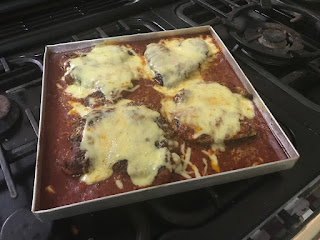Chicken Parm
Chicken Parm is one of those dishes that I feel is super under-represented. I mean, think about it. Everyone’s had countless plates of pasta and pizza, but how many of you have actually tried it? Yeah, I thought so.
For the uninitiated, chicken parm is actually quite simple. It’s a breaded, fried chicken breast that’s then baked in tomato sauce and cheese. What this means is we’re going to have 2 ingredient lists down below - one for the chicken and one for the tomato sauce. Also, keep in mind that I was cooking for 4 people, feel free to adjust the ingredients accordingly
 |
| Bread that thoroughly! |
For your chicken, you’re going to need :
Chicken breasts, butterflied - 4
Flour - 1/3 cup
Breadcrumbs - 1/2 cup
Oregano - 1 table spoon
Basil - 1 table spoon
Parmesan cheese (what else would we use in chicken parm, eh?) - 100g
Salt and pepper - to taste
2 Eggs
Mozzarella cheese - 200g
Now, you’re more than welcome to use whatever tomato sauce recipe you want but I used the one below to great effect :
Tomato puree - 500ml
Olive oil - 1/2 cup
Garlic - 5 cloves
Basil - 3 table spoons
Parmesan cheese (bet you were wondering where this would show up on the list) 100g
I recommend you start cooking your sauce first. It’s got to reduce to take the edge off the tomatoes, which is the perfect time to prepare your chicken.
 |
| Baste your chicken. Thank me later. |
Start by sautéing your garlic in the olive oil and basil. Keep the heat low and infuse as much flavour as possible into the oil. Once your garlic is soft and your oil is nice and fragrant, toss in your tomato puree, mix it thoroughly and crank the heat up. Make sure the sauce doesn’t stick to the pan so give it a mix every so often. If you find that the sauce is still a little acidic, add a spoon of sugar to take the edge off. This varies based on the tomato puree you use.
 |
| Pre-cheese |
While the sauce is cooking, you’ll need to prepare your breading station. Get 2 plates and a bowl : flour on plate 1, beat your eggs in the bowl and on your second plate, breadcrumbs.
I’ve seen people argue back and forth about their breadcrumbs - some people will grate parmesan into their bread, others don’t. Me? The more cheese the better, so grate about 100 grams of parmesan onto your breadcrumbs, season with salt and pepper and mix to make it uniform.
Start breading your butterflied chicken. Dip the chicken into the flour first and get a nice uniform coating, then into the beaten egg and finally into the breadcrumbs. Make sure that you’ve coated your chicken thoroughly with the breadcrumbs and you don’t have any bald spots.
 |
| All the cheese! |
A lot of people simply fry their chicken in plain olive oil, and you know what? I view that as a wasted opportunity to add some flavour so what I recommend is when you start heating the oil, add some basil, oregano and some chilli flake if you want some heat. Again, make sure you’ve infused flavour into that oil before you start frying your chicken. Make sure you remove anything you’ve added before you start frying though, otherwise it’ll end up burning.
Finally, baste your chicken with the oil for maximum flavour. This achieves two things : it adds flavour to the crumb and it partially cooks the other half of the chicken, reducing the amount of time you need to keep your chicken in the pan. Remember, this is going into the oven to bake as well so we don’t want to overcook anything.
Once you’ve fried up your chicken, pour your tomato sauce into a baking dish. Personally, I like to add some grated parmesan into the sauce for flavour but that’s up to you. Place your fried chicken into the tomato sauce, grate your mozzarella and parmesan cheeses and sprinkle liberally on top of each piece of chicken.
Finally, bake that at 200C until the cheese is melted. If you’ve got a grill, you can brown the cheese. If you’ve done it right, you’l’ have beautifully crisp, flavourful chicken along with a rich, velvety sauce with lots and lots of cheese. What’s not to like?
 |
| Don't be silly, there's no such thing as too much cheese. |



